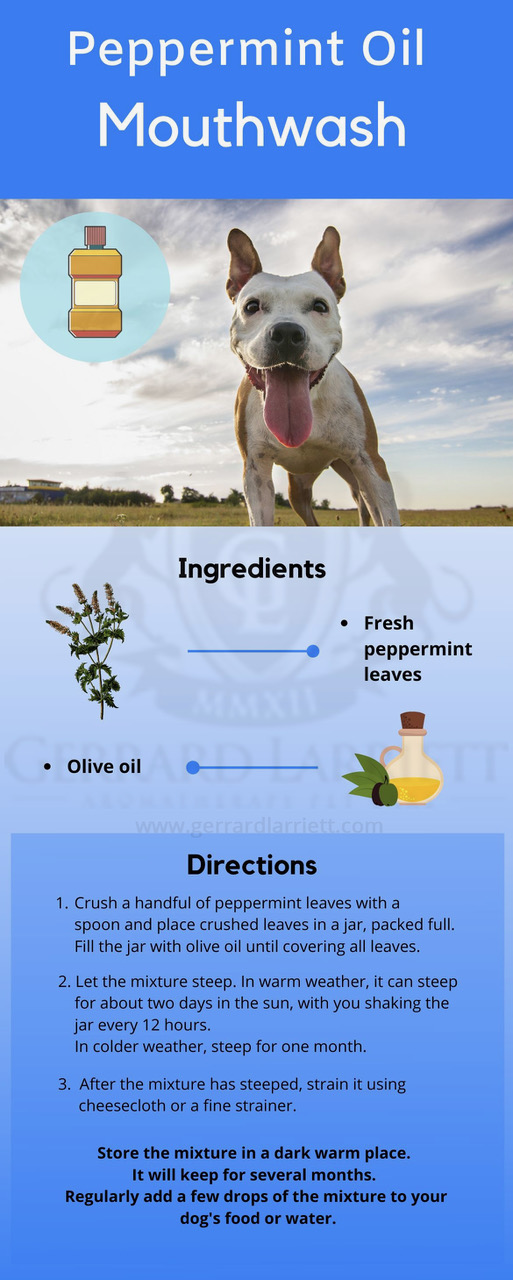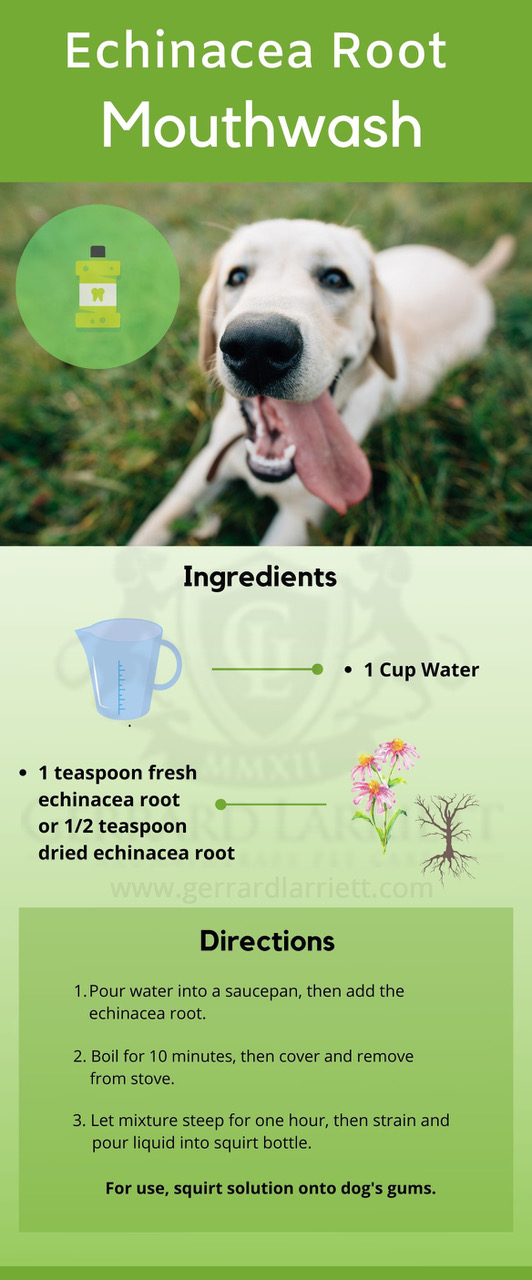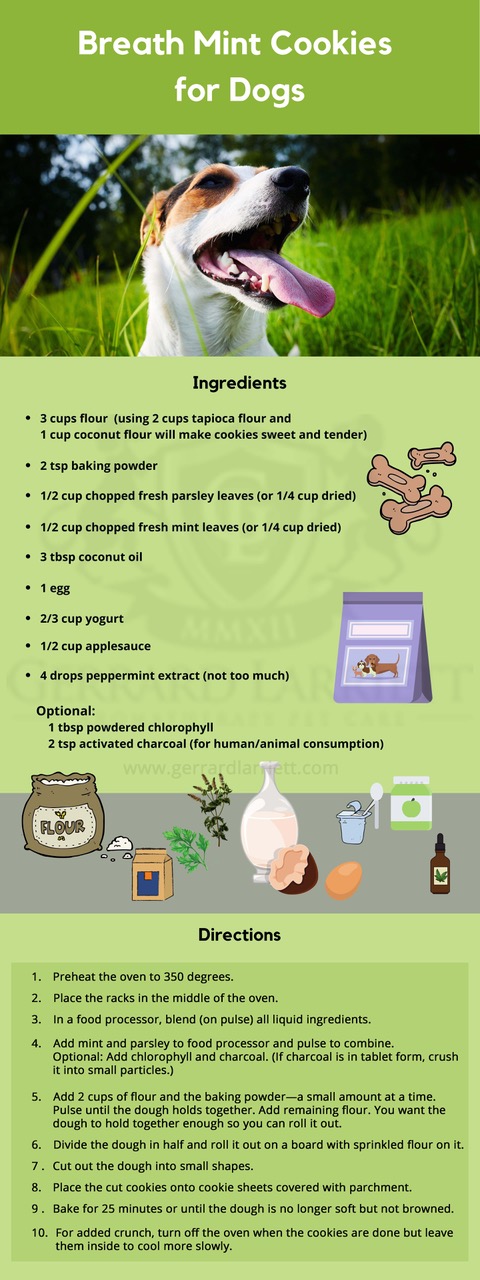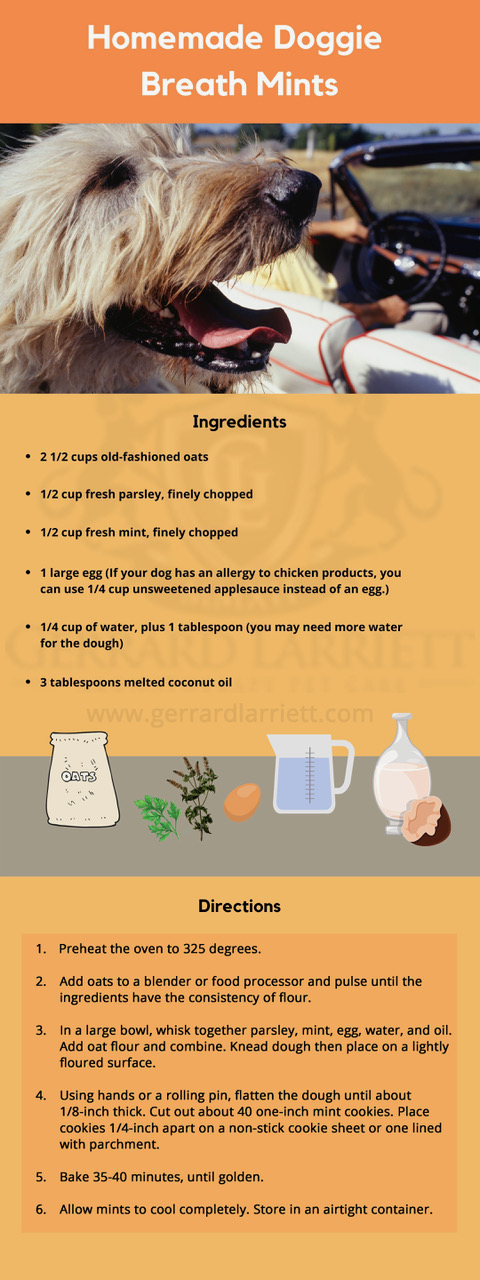Natural Remedies for Bad Dog Breath: Tips, Treats, and Teeth Brushing Techniques
A devoted pet lover and fragrance expert, Gerrard Larriett uses his over 10 years experience in the cosmetics industry to create a spa-inspired line of pet care products.
Many dogs have bad breath, unfortunately. Veterinarian Dr. Jennifer Coates shares tips to keep your dog’s breath fresh naturally. Plus, you’ll find DIY recipes for doggie toothpaste, mouthwash, and breath mints.
Inside this article:
- The first fix to bad dog breath: How to brush a dog’s teeth
- Herbs and spices that freshen a dog’s breath
- Pantry items you can use to cure bad breath
- Easiest natural way to freshen a dog’s breath
Causes of Bad Breath in Dogs
A dog’s bad breath is usually the result of an unclean mouth and dirty teeth. “The most common cause of bad breath in dogs is an accumulation of bacteria-laden plaque and tartar on teeth. If left untreated, the buildup can lead to inflammation, infection, and periodontal disease,” says Dr. Jennifer Coates, a veterinarian in Fort Collins, Colorado, and advisory board member of Pet Life Today.
But there can be other reasons for the bad breath as well:
- Unpleasant Dietary Habits: A dog that eats a variety of feces including, That of cats or even his own (called coprophagia), household garbage, or even decomposing birds and animals can get bad breath.
- Underlying Medical Condition: Bad breath could be a symptom of a medical problem beyond gum disease, including diabetes, kidney disease, and liver disease. “Bad breath can be a sign of serious health problems,” Dr. Coates shares. “Periodontal disease can lead to loose and missing teeth as well as infections in and around the mouth that may lead to problems elsewhere in the body, including the heart.”
Talk to your vet if bad breath persists even after you regularly clean your dog’s teeth.
How to Fix Your Dog’s Bad Breath Naturally: Brush their Teeth
Keeping your dog’s breath fresh can be as simple as brushing his teeth regularly. “The best way to promote good doggy breath is to brush your dog’s teeth every day, and to see your veterinarian regularly for wellness care,” explains Dr. Coates.
Here are the basics of brushing your dog’s teeth, along with some pointers:
- Check with Your Vet First: Before you start with a regular teeth-brushing regimen, bring your dog in for a check-up and ask your veterinarian if he needs a deeper cleaning first. Then, plan on having your vet do a deep cleaning of your dog’s teeth annually or at least every other year.
Dr. Coates advises, “If your dog has significant dental disease, schedule a dental evaluation and cleaning with your veterinarian before starting to brush his teeth, since the process may be painful.”
- Frequency: While it’s best to brush your dog’s teeth daily, you should at least try to do it once or twice a week for medium-sized and bigger dogs. For smaller dogs, daily brushing is crucial. Smaller breeds’ teeth are closer together and more prone to plaque and tartar buildup. The buildup can turn into periodontal disease, which causes bad breath and other problems.
How to Brush Your Dog’s Teeth Step-by-Step
- Get Comfortable
If your dog is small enough, hold him on your lap with his head facing away from you. If he is bigger, sit in a chair beside him so you can easily handle his mouth and teeth. - Lift His Lips
Use your index finger to push up your dog’s lips on one side of his mouth carefully. You can also place one hand over his head with your thumb and index finger on each side of his mouth. - Clean the Surface of His Teeth
Cover your finger with a soft cloth and rub over the outer surfaces of his teeth. Stay on the outside of his teeth, not the inside or the tips. Initially, rub over just his largest teeth and, in time, begin to rub all his teeth. - Try a Toothpaste Taste Test
When your dog’s comfortable with you rubbing his teeth, put a bit of the dog toothpaste on your finger and let him taste it. If that goes well, use the toothpaste on his teeth. “Flavored doggy toothpaste can improve your dog’s willingness to cooperate,” explains Dr. Coates. Do not use human toothpaste, which can be toxic to dogs. (See recipes for homemade dog toothpaste ) - Upgrade to a Toothbrush
Once your dog is comfortable with you rubbing his teeth with your finger, you can graduate to a dog toothbrush. Go gentle and slow with the toothbrush (and with your fingers) to make sure you don’t poke his gums. - Brush Teeth on Each Side for 30 Seconds
Try to brush his teeth for about 30 seconds per side. For the first few times, you might do only one side, then clean the other side a little later. “Gradually increase the amount of time you try to brush until you’re able to brush all your dog’s teeth in one sitting,” says Dr. Coates. - Reward Your Dog
Praise him throughout the process and give him treats when you finish. - Clean Your Hands
Wash your hands thoroughly when you’re done.
If at any time during the process, your dog shows signs of stress, go back a step and slowly proceed until he gets comfortable. You can also give him a break from brushing his teeth and try again at a later.
Dog Toothpaste
You can buy a commercial dog toothpaste that tastes good to your dog, or you can make your own. Never use human toothpaste on your dog. Human toothpaste may contain a substance called xylitol, which is toxic to your dog.
Natural Dog Toothpaste Recipes
You can easily make a natural toothpaste at home that works well and tastes good to your dog. Follow these recipes:

Recipe adapted from K9 Instinct

Recipe adapted from Modern Dog Magazine
Dog Toothbrushes and Alternatives
There are a few types of toothbrushes specifically made for dogs. The toothbrushes either have brushes with angled handles, a small brush that fits in your hand easily, or one that fits on your finger. Try the different versions until you find the toothbrush that works best for you and your dog. You can also just wrap soft gauze around your finger and put the dog toothpaste directly on that.
DIY Dog Mouthwashes Recipes
You can also buy a natural dog mouthwash/spray or make one at home that can cut down on bacteria in your dog’s mouth, which will keep his breath fresh. Try one of these doggy mouthwash recipes at home:

Recipe adapted from Rover.com

Recipe adapted from Cuteness
Natural Remedies for Bad Dog Breath
You don’t have to look further than your pantry or backyard (if you grow herbs) for natural cures for bad dog breath. When served in the right amounts, there are a variety of herbs, spices, fruits, and veggies that can help.
Herbs & Spices that Are Natural Breath Fresheners for Dogs
Parsley, mint, cinnamon, and wheatgrass are also natural solutions for bad breath that’s safe for dogs. Simply add a small amount of these items to your dog’s water or food. Then, sit back and enjoy his doggy kisses.
How to use herbs and spices to fight your dog’s bad breath:
- Parsley: Add some parsley to your dog’s food or include it in homemade treats. The herb contains chlorophyll, which fights bacteria in the mouth, and is a natural breath freshener (for humans, too). Use about one teaspoon of parsley for every 10 pounds your dog weighs.
- Mint: This herb also contains chlorophyll, so include only a small amount in his water or food.
- Cinnamon: This spice has the power to break up tiny food particles and prevent bacteria buildup. Add a few sprinkles of cinnamon to his food.
- Wheatgrass: You can buy a wheatgrass plant or grow one at home and give a small amount of the grass to your dog. The plant also contains chlorophyll and is an impressive odor neutralizer. Try turning the wheatgrass into a special treat for your dog: Puree the grass, then freeze it in an ice cube tray. Give your dog a cube to enjoy
Fruits, Veggies, & Treats that Get Rid of Bad Dog Breath
A wide range of crunchy fruits and vegetables can help clean your dog’s teeth and keep his breath fresher. As he chews them, it works a bit like a toothbrush, breaking up tartar, plaque buildup, and removing small food particles. Bite-size pieces of celery, apple slices, and carrots can all help fight bad breath. Puppies that are teething might enjoy gnawing on small frozen carrots. You can also make some homemade breath mints.
Recipes for Natural Breath Mints for Dogs

Recipe adapted from Rover.com

Recipe adapted from SkinnyMs.
Natural Breath Fresheners for Dogs Found in Your Pantry
You can also use some common products in your pantry to help freshen your dog’s breath. They include:
- Apple Cider Vinegar: Add about one-half teaspoon to your dog’s water bowl.
- Coconut Oil: Add a spoonful or so of the oil to your dog’s food to help fight gum disease. You can also brush your dog’s teeth with coconut oil in addition to using dog toothpaste.
- Neem Oil: Add a capsule of neem oil to their food once per week.
- Keep their Water Fresh: It’s also important to do something that involves no new product at all: Keep their water bowl clean, filling it with fresh water once or twice a day.
Probiotics for Bad Dog Breath
Probiotics help support beneficial bacteria in your dog’s body and can aid in digestion. Since probiotics can eliminate the harmful bacteria that can cause bad breath, it also means fresher breath for your dog.
Your vet may have suggestions for good probiotics for your dog. Some human foods that are safe for dogs and a good source of natural probiotics are yogurt and kefir. Bananas and small amounts of honey are a source of “prebiotics,” which supply food for probiotics. Don’t give raw honey to puppies or dogs with compromised immune systems.
Dog Bones and Bad Breath
Allowing your dog to chew bones can help scrape away dental plaque and keep his gums healthy. You should only allow your dog to chew on bones that are safe for him. Some recommendations:
- Don’t give him tough beef bones that could harm his teeth.
- Give him bones that are hard enough that they won’t splinter or break.
- Monitor your dog as he chews, to make sure bones don’t splinter.
- Don’t give him bones that are small enough for him to try to swallow.
- Look for natural marrow bones packaged for dogs at your pet store.
Dr. Coates generally advises her clients not to give their dogs raw bones, because of concern about pathogens like Salmonella.
Dental Chews to Help Freshen Your Dog’s Breath
Many kinds of dental chews, and types of dog food, can help clean your dog’s teeth and freshen his breath. Dogs that chew actively have much less plaque buildup on their teeth. Studies have shown that some dental treats and diets can reduce plaque by up to 70 percent.
Dr. Coates advises buying only chews or other dental treats that the Veterinary Oral Health Council (VHOC) recommends. The organization endorses products that have shown through verified research that they reduce plaque or tartar. Its website includes a list of VHOC approved dog products.
Primary types of dental treats, chews, and diets are:
- Dental chews, bones, biscuits
- Rawhide chews
- Dog food specially formulated to reduce plaque and tartar. Some items are manufactured as larger pieces that resist crumbling, while others have a special coating.
- Dog chew toys. You can also make some chew toys, especially helpful for dental health. For example, fill a Kong toy with dog toothpaste.
Be sure to avoid giving your dog pigs’ ears. While dogs may love chewing on pigs’ ears, studies have shown there is no real dental benefit to them. Pigs’ ears also can be contaminated with bacteria.
The Easiest Natural Way to Keep Your Dog’s Breath Fresh
Most dog owners I know would love to brush their dog’s teeth with natural toothpaste and bake homemade breath mints, but who has the time to do that regularly. I made our Natural Breath Freshener and Teeth and Gum Cleaner for Dogs to be part of a regular oral hygiene routine. It’s a quick, convenient solution to neutralizing your dog’s bad breath–simply spray the solution on your pet’s teeth, and that’s it.
Veterinarian’s recommend our all-natural breath freshener, which neutralizes the bacteria that can cause pet odor and tooth decay. We never use any hard chemicals or elements like paraben, alcohol, or phosphates. Instead, we use mint and aloe vera for their ability to fight bacteria and nourish sensitive skin. When used regularly, our Natural Breath Freshener and Teeth and Gum Cleaner for Dogs can prevent stains from forming and keep your dog’s breath fresh.
Learn more about our line of soothing and relaxing pet aromatherapy grooming products.


